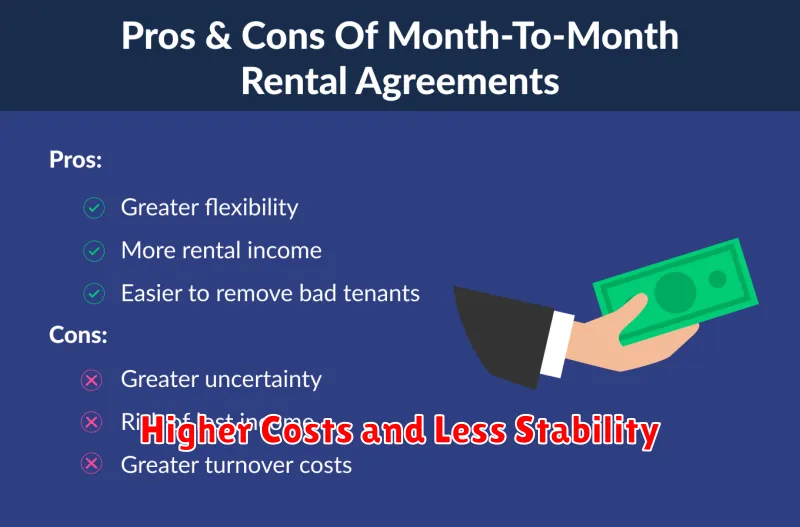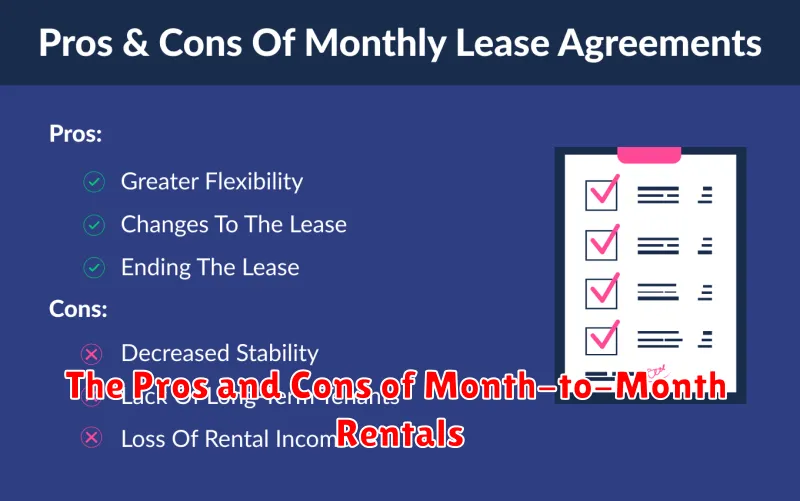Considering a month-to-month rental? Weighing the pros and cons of month-to-month rentals is crucial before signing a lease. This type of lease agreement offers flexibility, making it appealing to those with uncertain futures. However, month-to-month leases also come with potential drawbacks, such as rent increases and lease termination with short notice. Understanding both the advantages and disadvantages of month-to-month rentals will allow you to make an informed decision about whether this short-term housing solution is right for your current needs.
This article delves into the key pros and cons of month-to-month rent agreements. We will explore the benefits of month-to-month rentals, including increased flexibility and shorter commitment periods. We will also analyze the potential disadvantages, such as rent instability, lease termination risks, and the potential for higher rental costs compared to long-term leases. By examining both sides of the coin, you will be better equipped to determine if the month-to-month rental option aligns with your individual circumstances and long-term housing goals.
What Are Month-to-Month Leases?
A month-to-month lease, also known as a tenancy-at-will, is a rental agreement that renews each month for an indefinite period. Unlike a fixed-term lease (e.g., one year), both the landlord and tenant have the flexibility to terminate the agreement with proper notice, typically 30 days, although this can vary depending on local laws and the specific agreement. This type of lease offers more freedom but can also come with less stability.
Key benefits for tenants include flexibility to move with relatively short notice and the ability to avoid being locked into a long-term commitment. For landlords, month-to-month leases allow for more frequent rent adjustments and the opportunity to reclaim the property more quickly if needed. However, the primary drawback for tenants is the possibility of rent increases or lease termination with short notice. Landlords, conversely, face greater uncertainty regarding occupancy and consistent rental income.
Month-to-month leases are often favored by individuals experiencing life transitions, such as students, those relocating for work, or individuals unsure of their long-term housing needs. It’s crucial to understand the terms and conditions outlined in the written agreement, including notice requirements, rent payment details, and any other relevant clauses. This ensures both parties are protected and understand their rights and responsibilities.
Benefits of Flexibility and Freedom
Flexibility and freedom offer significant advantages in various aspects of life. In the workplace, flexibility can lead to increased productivity and job satisfaction. Employees with flexible schedules often experience reduced stress and a better work-life balance, allowing them to focus more effectively on their tasks. Freedom in the workplace, such as autonomy in decision-making, can foster creativity and innovation, leading to new ideas and improved processes. This sense of ownership can also boost morale and motivation.
Beyond the professional sphere, flexibility and freedom contribute to overall well-being. Having the flexibility to manage one’s time allows for greater control over personal pursuits, hobbies, and family commitments. The freedom to choose how and where to spend one’s time can reduce feelings of constraint and promote a sense of self-determination. This autonomy can lead to increased happiness and fulfillment.
Ultimately, the benefits of flexibility and freedom extend to both individuals and society. Flexible work arrangements can contribute to a more dynamic and responsive workforce, while personal freedom empowers individuals to pursue their goals and contribute meaningfully to their communities. This creates a more adaptable and thriving society overall.
Higher Costs and Less Stability

Increased costs are a significant consequence of various economic factors. These can include rising prices for raw materials, increased labor costs due to wage increases or shortages, and higher transportation expenses. Consumers ultimately bear the brunt of these increases, often seeing higher prices for everyday goods and services. Businesses may also struggle with reduced profit margins and the need to implement cost-cutting measures.
Reduced stability is another potential outcome of economic shifts. Market volatility, influenced by factors such as geopolitical events, changes in consumer confidence, and fluctuating currency exchange rates, can lead to uncertainty. This instability can make it difficult for businesses to plan for the future, impacting investment decisions and potentially leading to job losses. It can also create financial insecurity for individuals and families who may face unexpected expenses or reduced income.
The combined effect of higher costs and less stability can have a significant impact on overall economic health. This combination often contributes to reduced economic growth, increased inflation, and a decline in living standards. Addressing these challenges requires careful economic policy and strategic planning from both governments and businesses.
When Month-to-Month Makes Sense

Month-to-month leases offer flexibility, making them ideal for individuals experiencing periods of transition. This includes those relocating for a short-term job assignment, those who are house hunting and need temporary housing, or students completing an internship. The ability to terminate the lease with relatively short notice (typically 30 days) allows for greater control over living arrangements.
While often more expensive than longer-term leases, month-to-month agreements can be financially advantageous in certain situations. If you anticipate a move within a few months, a month-to-month lease avoids the potential penalties associated with breaking a traditional lease. This can outweigh the slightly higher monthly rental cost in the short term. It’s crucial to carefully weigh the costs and compare them with the potential expenses of breaking a longer lease.
However, it’s essential to be aware of the inherent instability of month-to-month arrangements. Your landlord can increase your rent or terminate the lease with proper notice, leaving you to search for new housing. Open communication with your landlord is essential to understand potential rent increases and lease renewals. This helps manage expectations and mitigate the risk of unexpected changes in your living situation.
Landlord Termination Policies
Termination of a lease agreement can occur for various reasons, outlined in the lease itself and governed by local and state laws. Landlords can typically terminate a tenancy for material breaches of the lease, such as consistent late rent payments, property damage exceeding normal wear and tear, or illegal activities on the premises. The termination process usually involves providing the tenant with a formal written notice specifying the reason for termination and the required timeframe for vacating the property. Failure to comply with the notice can lead to further legal action, including eviction.
Aside from breaches, landlords may also terminate a tenancy for non-renewal at the end of a fixed-term lease or by providing appropriate notice in a month-to-month agreement. The required notice period varies by jurisdiction and is often stipulated within the lease. Just cause eviction laws in some areas might require landlords to present valid reasons for termination even in month-to-month agreements. It’s crucial for both landlords and tenants to be aware of these local regulations to ensure a lawful and smooth termination process.
Retaliatory eviction, where a landlord terminates a lease in response to a tenant exercising their legal rights (such as requesting repairs or reporting code violations), is illegal. Tenants facing such situations should consult with local housing authorities or legal aid organizations. It’s always recommended to maintain clear communication and documentation throughout the tenancy to avoid misunderstandings and potential disputes during the termination process.
How to Transition to a Long-Term Lease
Transitioning to a long-term lease requires careful planning and negotiation. First, evaluate your current lease agreement. Understand the termination clause, including any penalties for breaking the lease early. Next, determine your long-term needs. Consider factors like space requirements, location preferences, and budget. Begin researching available properties that meet these criteria well in advance of your current lease expiration.
Once you’ve identified potential properties, contact the landlords or property managers to discuss lease terms. Negotiate key aspects such as the lease duration, rent amount, and any necessary renovations or improvements. Don’t hesitate to ask questions and clarify any uncertainties. It’s highly recommended to obtain legal counsel to review the proposed lease agreement before signing. This helps ensure your interests are protected and that you fully understand the terms and conditions.
Finally, plan the logistics of the move. This includes coordinating with movers, transferring utilities, and notifying relevant parties of your new address. Ensure you allow ample time for the transition process to avoid any last-minute complications. A well-planned transition can make the move into your long-term lease a smooth and successful experience.
Tips for Negotiating Terms
Preparation is key. Thoroughly research the other party’s needs and potential alternatives. Clearly define your own objectives, including your ideal outcome, walkaway point, and potential concessions. Understanding both sides’ positions will strengthen your negotiating stance.
During the negotiation, effective communication is crucial. Actively listen to understand the other party’s perspective and clearly articulate your own needs and proposals. Focus on building rapport and finding mutually beneficial solutions. Be prepared to compromise, but remain firm on your non-negotiable terms.
Finally, document everything. Keep detailed records of all communication, agreements, and concessions. This documentation will help prevent misunderstandings and ensure accountability for both parties after the negotiation concludes.

